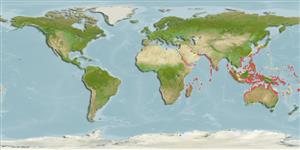Common names from other countries
>
Gobiiformes (Gobies) >
Gobiidae (Gobies) > Gobiinae
Etymology: Ctenogobiops: Greek, kteis, ktenos = comb + Latin, gobius = gudgeon + Greek, ops = appearance (Ref. 45335).
Environment: milieu / climate zone / depth range / distribution range
Ecologia
marinhas associadas(os) a recifes; intervalo de profundidade 1 - 15 m (Ref. 90102). Tropical
Indo-Pacific: widespread, from the Red Sea to the western Pacific, with records from the Great Barrier Reef and the Ryukyu Islands.
Tamanho / Peso / Idade
Maturity: Lm ? range ? - ? cm
Max length : 5.5 cm SL macho/indeterminado; (Ref. 90180)
Descrição suscinta
Chaves de identificação | Morfologia | Morfometria
Espinhos dorsais (total) : 7; Raios dorsais (total) : 11 - 12; Espinhos anais: 1; Raios anais : 11. This species is distinguished by the following characters: D VI + I,11-12; A I,11; pectoral rays 19; longitudinal scale series 55-60; body depth 4.8-5.2 in SL; head length (HL) 3.1-3.3 in SL; dorsal profile of snout forming an angle of about 40° to horizontal axis of head and body; wide gill opening, reaching forward nearly to a vertical at posterior edge of eye; 2nd dorsal spine equal to or slightly longer than first spine and longer than the third spine, and about equal to the body depth (0.9-1.1); rounded caudal fin, 1.1-1.3 in HL; body with 4 longitudinal rows of dark brown spots, the 1st and 3rd as thick dashes, the spots of second row much smaller, except large first one over upper end of gill opening; 4th row ventrally on body with 2 or 3 spots on abdomen approaching pupil size, remaining spots only dark flecks; postorbital head with 3 oblique rows of dark dashes at an angle less than 45°, the 1st a single long dash behind eye, the next 2 across cheek, ending on upper half of opercle; 4 oblique rows of dark brown dashes and dots from eye across lips; median, dark brown, V-shaped mark dorsally on snout absent; in life, no small yellow flecks ventrally on body; larger dark spots on ventral half of body often encircled with blue dots; pectoral fins with a small white dash at upper base, a long white streak from base, narrowing into middle of fin (Ref. 90180).
Ciclo de vida ou comportamento de acasalamento
Maturities | Reprodução | Spawnings | Egg(s) | Fecundities | Larvas
Kovačić, M., S.V. Bogorodsky and J.E. Randall, 2011. Redescription of the Red Sea gobiid fish Ctenogobiops maculosus (Fourmanoir) and validation of C. crocineus Smith. Zootaxa 3054:60-68. (Ref. 90180)
Status na Lista Vermelha da UICN (Ref. 130435)
CITES (Ref. 128078)
Not Evaluated
Ameaça para os humanos
Harmless
Uso pelos humanos
Ferramentas
Relatórios especiais
Baixar XML
Fontes da internet
Estimates based on models
Preferred temperature (Ref.
115969): 24.7 - 29.3, mean 28.4 (based on 2743 cells).
Índice de diversidade filogenética (Ref.
82804): PD
50 = 0.5020 [Uniqueness, from 0.5 = low to 2.0 = high].
Bayesian length-weight: a=0.00708 (0.00333 - 0.01504), b=3.09 (2.92 - 3.26), in cm Total Length, based on LWR estimates for this (Sub)family-body shape (Ref.
93245).
Nível Trófico (Ref.
69278): 3.5 ±0.45 se; based on food items.
Resiliência (Ref.
120179): Elevada, tempo mínimo de duplicação da população menor que 15 meses (Preliminary K or Fecundity.).
Fishing Vulnerability (Ref.
59153): Low vulnerability (10 of 100).
